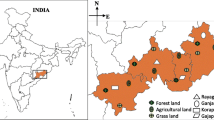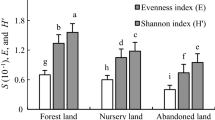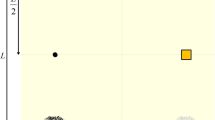Abstract
This study provides earthworm population data obtained from localities with a substantial anthropogenic impact spoils. The spoil heaps were reclaimed at the end of an opencast brown coal mining period. We studied spoils reclaimed by the two most commonly used reclamation processes: forestry and agricultural. The results show the significance of the locality age and the utilized reclamation process and treatment and their effect on earthworm communities. Our data indicate that apart from soil physical and chemical properties, the reclamation process itself may also induce viability and distribution of earthworm communities. Under standardized soil properties, the changes in earthworm populations during the succession were larger within the agricultural reclamation process as opposed to the forestry reclamation process for earthworm ecological groups and individual species.




Similar content being viewed by others
References
Barrios, E. (2007). Soil biota, ecosystem services and land productivity. Ecological Economics, 64(2), 269–285. doi:10.1016/j.ecolecon.2007.03.004.
Blouin, M., Hodson, M. E., Delgado, E. A., Baker, G., Brussaard, L., Butt, K. R., et al. (2013). A review of earthworm impact on soil function and ecosystem services. European Journal of Soil Science, 64(2), 161–182. doi:10.1111/Ejss.12025.
Cao, X. (2007). Regulating mine land reclamation in developing countries: the case of China. Land Use Policy, 24(2), 472–483. doi:10.1016/j.landusepol.2006.07.002.
Cesar, R., Natal-da-Luz, T., Sousa, J. P., Colonese, J., Bidone, E., Castilhos, Z., et al. (2014). Disposal of dredged sediments in tropical soils: ecotoxicological effects on earthworms. Environmental Monitoring and Assessment, 186(3), 1487–1497. doi:10.1007/s10661-013-3468-9.
Coleman, D. C., Crossley, D. A., & Hendrix, P. F. (2004). Fundamentals of soil ecology (2nd ed.). Burlington: Elsevier Academic Press.
Dunger, W., & Voigtländer, K. (2005). Assessment of biological soil quality in wooded reclaimed mine sites. Geoderma, 129(1–2), 32–44. doi:10.1016/j.geoderma.2004.12.028.
Flint, A. L., & Flint, L. E. (2002). Particle density. Methods of soil analysis: part 4 physical methods, 229–240.
Frouz, J., Keplin, B., Pižl, V., Tajovský, K., Starý, J., Lukešová, A., et al. (2001). Soil biota and upper soil layer development in two contrasting post-mining chronosequences. Ecological Engineering, 17(2–3), 275–284. doi:10.1016/S0925-8574(00)00144-0.
Frouz, J., Prach, K., Pižl, V., Háněl, L., Starý, J., Tajovský, K., et al. (2008). Interactions between soil development, vegetation and soil fauna during spontaneous succession in post mining sites. European Journal of Soil Biology, 44(1), 109–121. doi:10.1016/j.ejsobi.2007.09.002.
Frouz, J., Livečková, M., Albrechtová, J., Chroňáková, A., Cajthaml, T., Pižl, V., et al. (2013). Is the effect of trees on soil properties mediated by soil fauna? A case study from post-mining sites. Forest Ecology and Management, 309, 87–95. doi:10.1016/j.foreco.2013.02.013.
García-Ruiz, R., Ochoa, V., Viñegla, B., Hinojosa, M. B., Pena-Santiago, R., Liebanas, G., et al. (2009). Soil enzymes, nematode community and selected physico-chemical properties as soil quality indicators in organic and conventional olive oil farming: influence of seasonality and site features. [Article]. Applied Soil Ecology, 41(3), 305–314. doi:10.1016/j.apsoil.2008.12.004.
Gee, G. W., & Or, D. (2002). 2.4 Particle-size analysis. Methods of soil analysis. Part, 4, 255–293.
Gómez-Brandón, M., Lazcano, C., Lores, M., & Domínguez, J. (2010). Detritivorous earthworms modify microbial community structure and accelerate plant residue decomposition. Applied Soil Ecology, 44(3), 237–244. doi:10.1016/j.apsoil.2009.12.010.
Gómez-Brandón, M., Lores, M., & Domínguez, J. (2012). Species-specific effects of epigeic earthworms on microbial community structure during first stages of decomposition of organic matter. PLoS One, 7(2), e31895. doi:10.1371/journal.pone.0031895.
Gunn, A. (1992). The use of mustard to estimate earthworm populations. Pedobiologia, 36(2), 65–67.
Hendrychová, M., Šálek, M., Tajovský, K., & Řehoř, M. (2012). Soil properties and species richness of invertebrates on afforested sites after brown coal mining. Restoration Ecology, 20(5), 561–567. doi:10.1111/j.1526-100X.2011.00841.x.
Hernández, P., Fernández, R., Novo, M., Trigo, D., & Cosín, D. J. D. (2007). Geostatistical and multivariate analysis of the horizontal distribution of an earthworm community in El Molar (Madrid, Spain). Pedobiologia, 51(1), 13–21. doi:10.1016/j.pedobi.2006.11.002.
Hlava, J., & Kopecký, O. (2013). How reclamation type and age influence the abundance of earthworms in anthropogenic soils. Polish Journal of Environmental Studies, 22(6), 1887–1890.
ISO 10390 (2005). Soil Quality—Determination of pH. Geneva, Switzerland: International Organization for Standardization.
Khan, M. I., Cheema, S. A., Shen, C. F., Zhang, C. K., Tang, X. J., Shi, J. Y., et al. (2012). Assessment of phenanthrene bioavailability in aged and unaged soils by mild extraction. Environmental Monitoring and Assessment, 184(1), 549–559. doi:10.1007/s10661-011-1987-9.
Lavelle, P., & Spain, A. (2001). Soil ecology. Dordrecht: Kluwer Academic Publishers.
Lawrence, A. P., & Bowers, M. A. (2002). A test of the ‘hot’ mustard extraction method of sampling earthworms. Soil Biology & Biochemistry, 34(4), 549–552. doi:10.1016/S0038-0717(01)00211-5.
Muys, B., & Granval, P. (1997). Earthworms as bio-indicators of forest site quality. Soil Biology & Biochemistry, 29(3–4), 323–328. doi:10.1016/S0038-0717(96)00047-8.
Oehlmann, J., & Schulte-Oehlmann, U. (2003). Molluscs as bioindicators. Trace Metals and other Contaminants in the Environment, 6, 577–635.
Paoletti, M. G. (1999). The role of earthworms for assessment of sustainability and as bioindicators. Agriculture Ecosystems & Environment, 74(1–3), 137–155. doi:10.1016/S0167-8809(99)00034-1.
Parmenter, R. R., Macmahon, J. A., & Gilbert, C. A. B. (1991). Early successional patterns of arthropod recolonization on reclaimed Wyoming strip mines—the grasshoppers (Orthoptera, Acrididae) and allied faunas (Orthoptera, Gryllacrididae, Tettigoniidae). Environmental Entomology, 20(1), 135–142.
Pižl, V. (1992). Succession of earthworm populations in abandoned fields. Soil Biology & Biochemistry, 24(12), 1623–1628. doi:10.1016/0038-0717(92)90160-Y.
Pižl, V. (1999). Development of earthworm populations in afforested colliery spoil heaps in northern Bohemia, Czech Republic. Pedobiologia, 43(6), 691–697.
Pižl, V. (2002). Žížaly České republiky - Earthworms of the Czech Republic: Přírodovědný klub v Uherském Hradišti.
Pospíšil, F. (1964). Fractionation of humus substances of several soil types in Czechoslovakia. Rostlinná Výroba, 10, 567–580.
Rhoades, J. (1996). Salinity: electrical conductivity and total dissolved solids. Methods of soil analysis part 3—chemical methods(methodsofsoilan3), 417–435.
Rossi, J. P., Huerta, E., Fragoso, C., & Lavelle, P. (2006). Soil properties inside earthworm patches and gaps in a tropical grassland (la Mancha, Veracruz, Mexico). European Journal of Soil Biology, 42, S284–S288. doi:10.1016/j.ejsobi.2006.07.024.
Roubíčková, A., Mudrák, O., & Frouz, J. (2009). Effect of earthworm on growth of late succession plant species in postmining sites under laboratory and field conditions. Biology and Fertility of Soils, 45(7), 769–774. doi:10.1007/s00374-009-0386-7.
Schulz, F., & Wiegleb, G. (2000). Development options of natural habitats in a post-mining landscape. Land Degradation & Development, 11(2), 99–110. doi:10.1002/(Sici)1099-145x(200003/04)11:2<99::Aid-Ldr368>3.3.Co;2-9.
Shin, K. H., & Kim, K. W. (2001). Ecotoxicity monitoring of hydrocarbon-contaminated soil using earthworm (Eisenia foetida). Environmental Monitoring and Assessment, 70(1–2), 93–103. doi:10.1023/A:1010685331222.
Simpson, J. E., Slade, E., Riutta, T., & Taylor, M. E. (2012). Factors affecting soil fauna feeding activity in a fragmented lowland temperate deciduous woodland. PLoS One, 7(1), e29616. doi:10.1371/journal.pone.0029616.
Sims, R. W., & Gerard, B. M. (1985). Earthworms: keys and notes for the identification and study of the species (Vol. 31): Brill Archive.
Six, J., Bossuyt, H., Degryze, S., & Denef, K. (2004). A history of research on the link between (micro)aggregates, soil biota, and soil organic matter dynamics. Soil & Tillage Research, 79(1), 7–31. doi:10.1016/j.still.2004.03.008.
Skjemstad, J., & Baldock, J. A. (2007). Total and organic carbon. In Soil sampling and methods of analysis (2nd ed., pp. 225–237). Boca Raton: CRC Press.
Statsoft Inc (2012). STATISTICA (data analysis software system), ver. 12.
Stöp-Bowitz, C. (1970). A contribution to our knowledge of the systematics and zoography of Norwegian earthworms (Annelida oligochaeta: Lumbricidae). Oslo: Oslo Universitetsforl.
ter Braak, C. J., & Smilauer, P. (2002). Canoco 4.5: Reference Manual and Canodraw for Windows. User’s Guide: Software Form Canonical Community Ordination (version 4.5). Ithaca: Microcomputer Power.
Tondoh, J. E., Monin, L. M., Tiho, S., & Csuzdi, C. (2007). Can earthworms be used as bio-indicators of land-use perturbations in semi-deciduous forest? Biology and Fertility of Soils, 43(5), 585–592.
Topp, W., Gemesi, O., Grüning, C., Tasch, P., & Zhou, H.-Z. (1992). Fortsliche Rekultivierung mit Altwaldboden im Rheinischen Braunkohlenrevier. Die Sukzession der Bodenfauna. Zoologische Jahrbücher. Abteilung für Systematik, Ökologie und Geographie der Tiere, 119(4), 505–533.
Tropek, R., Kadlec, T., Karesova, P., Spitzer, L., Kocarek, P., Malenovsky, I., et al. (2010). Spontaneous succession in limestone quarries as an effective restoration tool for endangered arthropods and plants. Journal of Applied Ecology, 47(1), 139–147. doi:10.1111/j.1365-2664.2009.01746.x.
Tropek, R., Kadlec, T., Hejda, M., Kocarek, P., Skuhrovec, J., Malenovsky, I., et al. (2012). Technical reclamations are wasting the conservation potential of post-mining sites. A case study of black coal spoil dumps. Ecological Engineering, 43, 13–18. doi:10.1016/j.ecoleng.2011.10.010.
Wanner, M., & Dunger, W. (2002). Primary immigration and succession of soil organisms on reclaimed opencast coal mining areas in eastern Germany. European Journal of Soil Biology, 38(2), 137–143. doi:10.1016/S1164-5563(02)01135-4.
Wiegleb, G., & Felinks, B. (2001). Primary succession in post-mining landscapes of Lower Lusatia—chance or necessity. Ecological Engineering, 17(2–3), 199–217. doi:10.1016/S0925-8574(00)00159-2.
Acknowledgments
We would like to thank Christopher Ash for text revision. We thank the Czech Coal Group Company for permission to use reclaimed areas in this research. The study was supported by the “S-grant” of The Ministry of Education, Youth and Sports of the Czech Republic.
Author information
Authors and Affiliations
Corresponding author
Rights and permissions
About this article
Cite this article
Hlava, J., Hlavová, A., Hakl, J. et al. Earthworm responses to different reclamation processes in post opencast mining lands during succession. Environ Monit Assess 187, 4108 (2015). https://doi.org/10.1007/s10661-014-4108-8
Received:
Accepted:
Published:
DOI: https://doi.org/10.1007/s10661-014-4108-8




